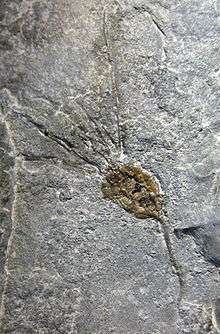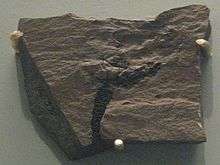Gogia
| Gogia Temporal range: late Early Cambrian–Middle Cambrian | |
|---|---|
 | |
| G. kitchnerensis specimen from Utah | |
 | |
| A colourful reconstruction of G. ojenai | |
| Scientific classification | |
| Kingdom: | Animalia |
| Phylum: | Echinodermata |
| Subphylum: | †Blastozoa |
| Class: | Eocrinoidea Miller, 1821 |
| Order: | Gogiida |
| Family: | Eocrinidae |
| Genus: | Gogia Walcott 1917 |
| Type species | |
| G. prolifica | |
| Species | |
| Synonyms | |
| |
Gogia is a genus of primitive eocrinoid blastozoan from the early to middle Cambrian.
G. ojenai dates to the late Early Cambrian;[3] other species come from various Middle Cambrian strata throughout North America, but the genus has yet to be described outside this continent.[2]
The species of Gogia, like other eocrinoids, were not closely related to the true crinoids, instead, being more closely related to the blastoids.

Gogia is distinguished from sea lilies, and most other blastoids, in that the plate-covered body was shaped like a vase, or a bowling pin (with the pin part stuck into the substrate), and that the five ambulacra were split into pairs of coiled or straight, ribbon-like strands. Six specimens of Gogia are known from the Greater Phyllopod bed, where they comprise < 0.1% of the community.[4]
As a whole, the Eocrinoids are regarded as basal blastozoans very close to the ancestry of the entire subphylum.
External links
- "Gogia stephenensis". Burgess Shale Fossil Gallery. Virtual Museum of Canada. 2011.
References
- ↑ Redescribed in Harker, P.; Hutchinson, R. D. (1953). "A New Occurrence and Redescription of Gogia prolifica Walcott". Journal of Paleontology. Paleontological Society. 27 (2): 285–287. doi:10.2307/1300058 (inactive 2015-03-21). JSTOR 1300058.
- 1 2 3 4 5 6 Robison, R. A. (1965). "Middle Cambrian Eocrinoids from Western North America". Journal of Paleontology. Paleontological Society. 39 (3): 355–364. doi:10.2307/1301709 (inactive 2015-03-05). JSTOR 1301709.
- 1 2 Durham, J. W. (1978). "A Lower Cambrian Eocrinoid". Journal of Paleontology. Paleontological Society. 52 (1): 195–199. doi:10.2307/1303808 (inactive 2015-01-09). JSTOR 1303808.
- ↑ Caron, Jean-Bernard; Jackson, Donald A. (October 2006). "Taphonomy of the Greater Phyllopod Bed community, Burgess Shale". PALAIOS. 21 (5): 451–65. doi:10.2110/palo.2003.P05-070R. JSTOR 20173022.